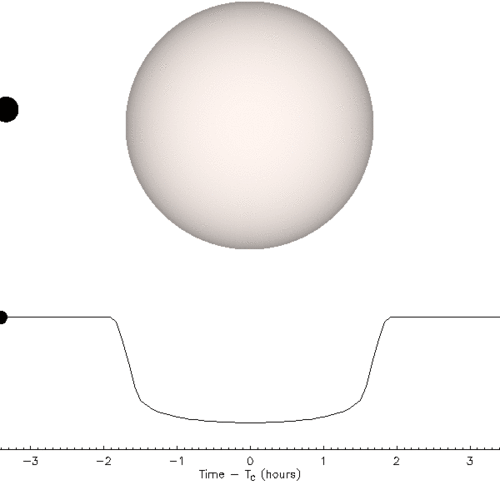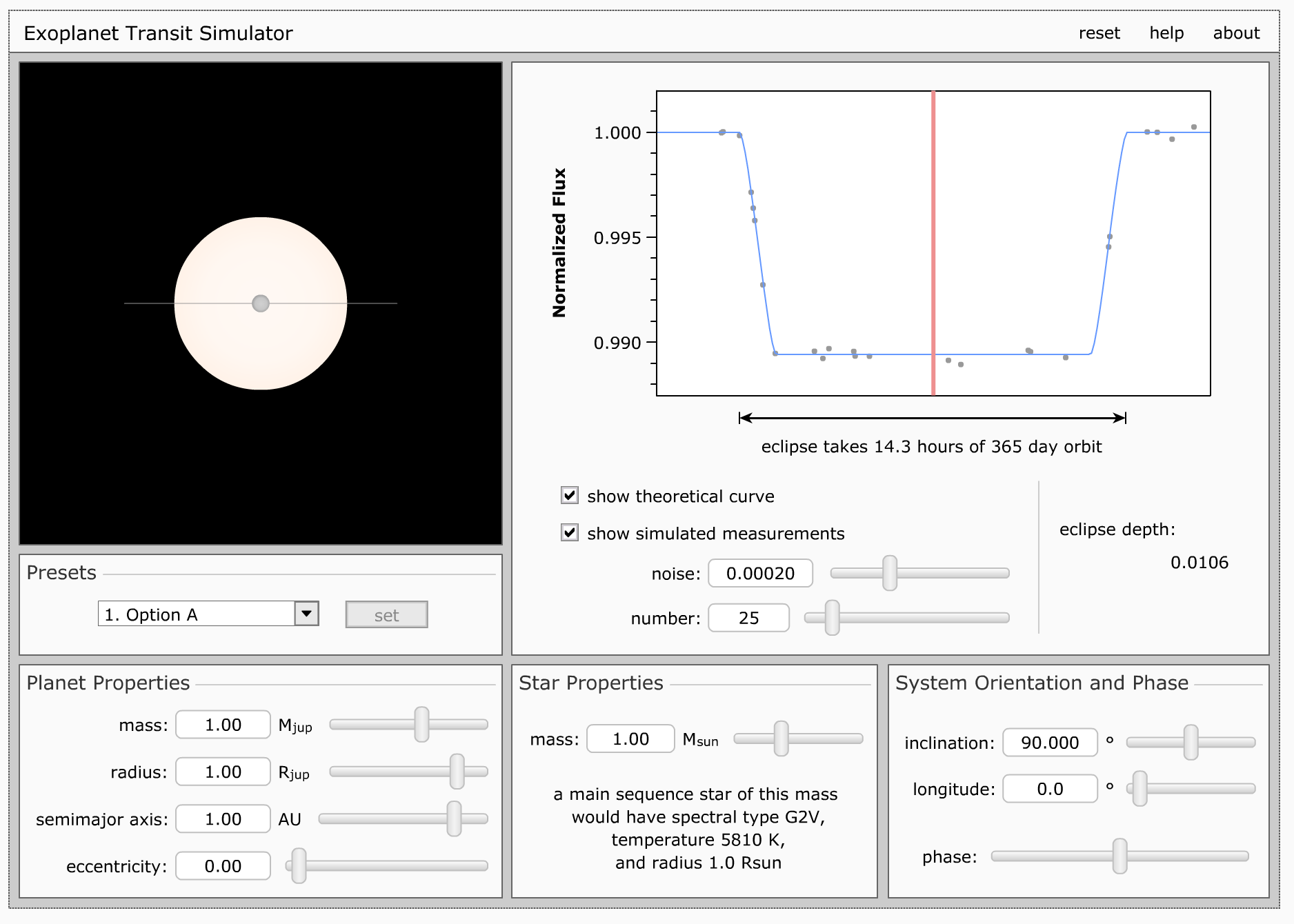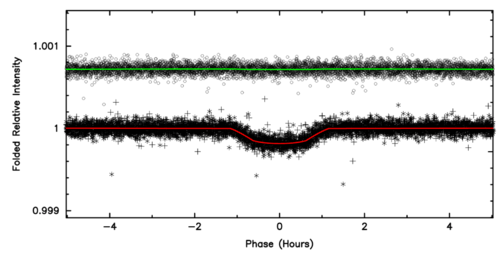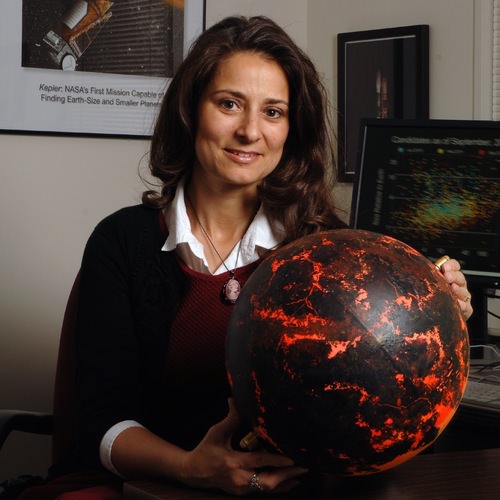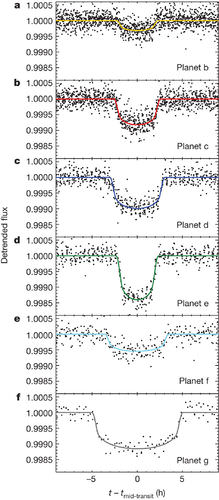10.4 过境方法
章节大纲
-
By 1999, about a dozen planet candidates had been detected with the Doppler technique, and most were similar to 51 Peg b, with of about one Jupiter mass and orbits of just a few days. Even the astronomers working with the Doppler method were deferential in calling these objects planet "candidates" in those early days because the true mass of the orbiting companion could not be determined with this detection technique.
::到1999年,已经检测到大约十几个行星候选者使用了多普勒技术,其中多数与51个比格(Peg b)相似,其中木星质量约1个,轨道仅数日。 甚至与多普勒方法合作的天文学家在那些早期将这些天的行星称为“候选人 ” , 因为这一探测技术无法确定轨道伙伴的真正质量。However, astronomers knew that if these really were planets (and not face-on stellar binary systems), about one in ten of the short-period 51 Peg b type objects would have an orbit that was oriented so that the planet would "transit" or cross our line of sight to the star. When that happens, the planet blocks some of the starlight for the few hours that it transits.
::然而,天文学家们知道,如果这些真的是行星(而不是表面上的恒星二元系统),那么在51个短周期的Pegb型物体中,大约十分之一的短时间里,星体将有一个方向轨道,使行星能够“转换”或越过我们的视线进入恒星。一旦发生这种情况,行星将星光中的一些星光阻塞数小时。Measuring the brightness of stars is relatively straightforward, and each of the stars with 51 Peg b type objects was being monitored for a possible transit. While the Doppler technique cannot determine the inclination, the data do predict when a planet will transit if the inclination is viewed nearly edge-on. If a planet transits, we know that and therefore, . In this case, the Doppler measured mass is no longer just ; it is the total, true mass of the planet.
::测量恒星的亮度相对直截了当, 而每个具有51个比格b型天体的恒星都受到监测, 以便进行可能的中转。 虽然多普勒技术无法确定倾斜度, 但数据的确预示了一个行星何时会经过, 如果倾角被看得接近边缘。 如果一个行星过境, 我们知道, i90, 因此, sini1.0 。 在这种情况下, 多普勒测量的质量不再仅仅是 mlsini; 它就是地球的总数, 真正的质量 。When orbits are viewed edge-on, the planet transits, or crosses our line of sight to the host star. What is the relationship between the size of the planet and the amount of starlight that is blocked (i.e., the depth of the transit)?
::当轨道被观察时,行星会穿过边缘,或者越过我们的视线到主星。行星的大小与被阻塞的星光数量(即中转深度)之间有什么关系?The above illustrates what is happening. During a transit the planet passes in front of the star (top animation), and as this happens the brightness of the star decreases (bottom animation). We do not actually have pictures like the top animation because stars are point sources of light, not resolved objects. The data that we have are the time series photometry (brightness measurements) depicted in the lower animation that show a regular and periodic decrease in the brightness of the star at precisely the putative time time (predicted by the Doppler velocity measurements). Because we cannot resolve the image of the planet (or the star), this is still an indirect detection technique. However, even astronomers sometimes take some poetic license here and say that we are seeing the shadow (or the silhouette) of the planet.
::上面描述正在发生的情况。 在星体前的中转期间, 行星在星体前传递( 上方动画) , 并且随着恒星的亮度下降( 下方动画 ) 。 我们实际上没有像顶层动画那样的图片, 因为恒星是光点源, 而不是解析对象。 我们掌握的数据是下层动画中的时间序列光度测量( 亮度测量) , 显示恒星的亮度在假设的时间( 多普勒速度测量 ) 定期下降( 由多普勒速度测量 ) 。 因为我们无法解决行星( 或恒星) 的图像, 这仍然是一个间接的探测技术。 然而, 即使天文学家有时在这里取得一些诗意的许可, 并说我们正在看到行星的阴影( 或光影 ) 。There is only one case where we can resolve the physical extent of star, and that is for our Sun. If the Earth is in the right position on our orbit around the Sun, we can see the inner planets, Mercury and Venus, transiting the Sun. This fortuitous alignment happens about 13 times a century for Mercury and fewer than 2 times per century for Venus. The video below shows the transit of Venus, seen from Trondheim, Norway in June 2004. You will have to wait until Dec 10, 2117, to see the next transit of Venus. Can you estimate the transit depth for Venus crossing the Sun?
::只有一个例子我们可以解决恒星的物理范围,那就是我们的太阳。如果地球处于太阳轨道上正确的位置,我们可以看到内行星,水星和金星,穿过太阳。这个偶然的对齐发生于一个世纪的汞约13次,金星每世纪不到2次。下面的视频显示金星的过境情况,2004年6月从挪威特隆赫姆看到。你必须等到2117年12月10日才能看到下一个金星的过境情况。你能估计金星穿越太阳的过境深度吗?The first transiting exoplanet
::第一个中转的外行星网HD 209458 b was the first star where astronomers observed a transiting exoplanet. The planet had a mass similar to Jupiter's with a short orbital period of just a few days, and was independently detected by two teams using the Doppler method in the summer of 1999. HD 209458 b was the twelfth example of a 51 Peg b analog -- r ecall that about one in ten close-in planets was expected to transit -- and the planet hunters were anxiously awaiting the validation of "planet" status that a transit would bring.
::HD 209458 b 是天文学家观测到一个中转外行星的第一颗恒星。行星的重量与木星相似,短轨道周期仅为几天,1999年夏季由两个小组使用多普勒方法独立检测,HD 209458 b 是51个比格模拟的第十二个例子 -- -- 记得大约10个近距离行星中有1个预计将过境 -- -- 行星猎人急切地等待着验证一个中转卫星的“平面”状态。In August and September 1999, the team led by Harvard graduate student David Charbonneau and Dr. Tim Brown, observed a transit at the time predicted by the Doppler velocity data. Their published data is shown in the below. The ground based photometry is good enough that you can unambiguously see the transit event, but the scatter in the published relative flux over time reflects measurement errors from atmospheric scintillation - the twinkling effect on starlight caused by differences in temperature and pressure in different layers of the atmosphere. The team phase-folded the photometric data at one orbital period to strengthen the fidelity of the repeating signal and were able to reduce their errors to 0.015%. This precision is impressive, but not high enough to detect a transiting planet like the Earth with a radius that is one tenth of Jupiter. A second team, led by Greg Henry, measured a partial transit in November of that same year, and the two discovery papers were published back-to-back in the Astrophysical Journal.
::1999年8月和9月,由哈佛研究生David Charbonneau和Tim Brown博士率领的团队在Dopler速度数据预测的时间里观察到了一个中转点,其公布的数据显示在下面。地面光度测量足够好,可以毫不含糊地看到中转事件,但公布的相对通量随时间推移的散射反映了大气闪烁的测量错误 -- -- 温度和大气不同层压力对星光的交汇效应。团队在一个轨道期间将光度数据相加,以加强重复信号的忠实性,并能够将其误差降低到0.015 % 。这一精确度令人印象深刻,但不足以探测像地球这样半径为木星十分之一的中转行星。第二队由Greg Henry率领,于同年11月测量了部分中转,另外两篇发现论文在《天体物理日报》上连续发表。Photometry (measurement of brightness) of the star HD 209458 showed a decrease in brightness for a few hours in August 1999 and again in September 1999 at the time when the Doppler observations suggested that the planet should be passing in front of the star. What is the duration and fractional depth of the transit of HD 209458b? What causes scatter in the photometric measurements?
::1999年8月和1999年9月,当多普勒观测显示行星应该经过恒星前时,HD 209458号恒星的光度测量(光度测量)显示亮度下降几小时,1999年8月和1999年9月再次下降。HD 209458b号恒星过境的长度和分深度是多少?光度测量中是什么原因造成的散射?The depth of the transit tells us about the relative size of the planet and star. Imagine a planet that is large enough to completely cover (eclipse) the star during transit. In this extreme case, the brightness of the star would drop to zero. However, the typical case is that planet is much smaller than the star, and in this case the brightness of the star decreases by the ratio:
::中转深度告诉我们行星和恒星的相对大小。 想象一个足以完全覆盖( 椭圆) 运行中的恒星的行星。 在这种极端情况下, 恒星的亮度会下降到零。 然而, 典型的例子是行星比恒星小得多, 而在这种情况下, 恒星的亮度会降低 :[Eqn 1]
::BB = 横跨横跨横跨横跨横跨横跨四面层的平面板块= (planetR*)2 = (rplanetR*)2 [Eqn 1]Equation 1 says that the fractional change in brightness of the star is proportional to the radius of the planet to the star. We measure the brightness of the star without a transit and the decreased brightness during transit. So, if we know the radius of the star, we can solve this equation to derive the radius of a planet that we cannot even see. Science is amazing!
::等式 1 表示恒星亮度的分数变化与行星半径与恒星成正比。 我们测量恒星的亮度时没有中转和在中转期间亮度下降。 因此, 如果我们知道恒星半径, 我们就能解开这个方程式, 得出一个甚至看不到的行星半径。 科学是惊人的 !I n our everyday lives, we have a lot of experience with what artists call perspective. Objects that are closer to us look larger than objects that are farther away. This sometimes lead to an incorrect intuition that transit depth is related to the star-planet separation since the more distant planet are "closer" to us. However, the incredible distances to the stars that we observe mean that the difference in star-planet distances within a given planetary system are negligible.
::在我们的日常生活中,我们有很多关于艺术家所谓的视角的经验。更接近我们的物体看起来比距离更远的物体要大。这有时导致一种不正确的直觉,即中转深度与恒星和行星的分离有关,因为距离更远的行星对我们来说“更近 ” 。然而,我们观察到的与恒星的令人难以置信的距离意味着恒星和行星系统距离的差别微乎其微。Transit Probability
::过境概率Do all planets have an equal probability of transiting, or do some planets have a higher transit probability?
::是所有行星的过境概率相等,还是有些行星的过境概率较高?What factors might improve the chances that a planet will transit?
::哪些因素会增加一个星球过境的机会?Transit probability
::过境概率The transit probability depends on the serendipitous tilt, or inclination, of the orbital plane of the planets. If the planetary system is viewed "face-on" (by definition, this inclination angle is zero) then the planets will not transit. If the planetary system is exactly "edge-on" (in this case, the inclination angle is 90 degrees), then the planet will always transit. But what is the probability that a planet will transit if the inclination of the orbital plane is somewhere in between these two extremes? For these cases, the transit probability depends on the radius of the star and the distance between the star and the planet. The transit probability is derived from this geometry and expresses a simple dependency between stellar radius, R , and the star-planet distance, a , in the simple form:
::中转概率取决于行星轨道平面的表面倾斜或倾角。 如果行星系统被看成“ 正面” (定义,这个倾角为零) , 那么行星就不会过境。 如果行星系统完全是“ 边缘” (在此情况下,倾角为90度) , 那么行星总是会过境。 但如果轨道平面的倾角处于这两个极端之间, 行星的中转概率是多少? 对于这两种情况, 中转概率取决于恒星的半径和恒星与行星之间的距离。 中转概率来自这一几何方法, 表示恒星半径、 R 和恒星- 平面距离之间的简单依赖, 一种简单的形式是:[Eqn 2]
::P(过境)=Ra [Eqn 2]Equation 2 captures the idea that larger stars present a bigger target for prospective transits (although the transit depth will be shallower and may be harder to detect than with smaller stars). Likewise, planets that are closer to the star are more likely to transit.
::等式2捕捉到一个想法,即较大的恒星为未来的中转目标提供了更大的目标(尽管中转深度会更浅,而且可能比较小恒星更难探测 ) 。 同样,接近恒星的行星更有可能中转。If one planet transits its host star, will all of the other planets transit, too? Not necessarily. As shows, it is more probable that the inner planets will transit. A more distant planet in the system could avoid transiting even if the system is perfectly co-planar.
::如果一个行星在宿主星中转,其他所有行星也都会在宿主星中转来转去吗?不一定。正如所显示的那样,内行星更有可能在内行星中转来转去。 系统中一个更遥远的行星即使系统是完全合机的,也有可能避免在系统中转来转去。When a planet passes between our line of site to a star, it blocks out some of the starlight and is said to transit. Consider a star with two planets that orbit in a plane inclined by an angle, i, to our line of site. The closest planet has a semi-major axis a1 that clips our view of the star. The second planet will not block our view of the star - it will not transit. How does the range of possible inclination values compare for close-in and more distant transiting planets?
::当一个行星从我们的位置线向恒星穿行时,它将一些星光屏蔽起来,并据说是中转的。 想象一下, 一颗有两个行星的恒星, 以一个角度, 即我们的位置线旋转的平面运行。 最接近的行星有一个半主轴 a1 , 剪切了我们对恒星的视野。 第二个行星不会阻挡我们对恒星的视线—— 它不会传递。 可能的倾角值范围如何与近近行星和更远的中转行星相比较?Use the NAAP transit simulator (download from and install on your computer, then open the Exoplanet Transit Simulator) to understand how transiting exoplanets are detected with time series photometric data. Set up the simulator using the settings listed below:
::使用 NAAP 中转模拟器( 从计算机上下载并安装, 然后打开 Exoplanet 中转模拟器) 来理解如何用时间序列光度测量数据探测到流转的Exoplantets。 使用以下设置设置设置设置设置模拟器 :-
Familiarize yourself with the input widgets in the bottom three frames of the Transit Simulator window.
::使您熟悉 Transport模拟器窗口底部三边框中的输入部件 。 -
Set the planet properties as shown: a 1 Mjup planet with a radius of 1 Rjup orbiting at 1 AU with zero eccentricity.
::设定显示的行星属性: 1 Mjup 行星,半径为 1 Rjup 轨道为 1 AU, 零偏心。 -
Set the mass of the star to be equal to the mass of the Sun.
::设定恒星质量等于太阳质量。 -
Keep the system orientation with an edge-on inclination of 90 degrees with a longitude of zero.
::使系统方向保持90度的边缘倾角,经度为零。 -
In the output window, toggle on the theoretical curve and the simulated measurements. Select "noise" in the data of 0.00020, typical errors in the
Kepler
data.
::在输出窗口中, 切换到理论曲线和模拟测量。 在 0.00020 的数据中选择“ 噪音 ” , 即 Kepler 数据中的典型错误 。 -
Use the sliders to observe the impact on the data when the noise is increased and the number of observations is 10 or 100.
::当噪音增加,观测次数为10或100时,使用滑动器观察对数据的影响。 -
Check to see how the mass of the star affects the strength of the transit signal (notice that the numbers on the y-axis will change). A lower mass star is smaller and fractionally more light is blocked out than for a high mass star with a large radius.
::检查恒星的质量如何影响中转信号的强度( 注意 Y 轴上的数字将会改变 ) 。 低质量恒星较小, 少部分的光被阻断, 比大半径高质量恒星的亮度还要小。 -
The Earth has a mass that is 0.0032 times the mass of Jupiter and a radius that is about 0.1 times the radius of Jupiter. Change the planet mass and radius in the simulator to these value. Notice that the real change in the transit signal occurs when the radius, not the mass, is changed. Is there any way of convincingly detecting an Earth analog (Earth-size planet at 1 AU) around a solar mass star with the precision of 0.0002? What precision do you need to be able to convincingly see the transit dip?
::地球质量为木星质量的0.0032倍,半径约为木星半径的0.1倍。 将行星质量和模拟器半径改变为这些值。 请注意, 中转信号的真正变化是在半径而不是质量变化时发生的。 是否有办法令人信服地探测到太阳质量恒星周围的地球模拟( 1AU 1 的地球大小行星) , 精确度为 0.0002 ? 您需要什么精确度才能令人信服地看到中转点 ?
Simulation of transit data.
::模拟过境数据。The Kepler Mission
::开普勒代表团A decade before the first exoplanet was discovered, William Borucki, a scientist at NASA Ames Research Center in Mountainview CA, wrote a paper "The Photometric Method of Detecting Other Planetary Systems" (Borucki & Summers 1984) where he made the case for a space mission to detect planets orbiting other stars using the transit technique. It took more than twenty years of advocacy, but Borucki's persistence paid off. The first exoplanets were discovered in the mid-1990s, heating up interest, and after the first ground-based transit discovery in 2000, the exoplanet community rallied behind Bill Borucki's plan.
::在发现第一个外行星之前的十年,美国航天局山景CAAmes研究中心的科学家William Boruki撰写了一篇题为“探测其他行星系统的光度测量方法”的论文(1984年博鲁基和夏季),其中他提出空间飞行任务可以探测利用中转技术绕着其他恒星运行的行星。这花费了20多年的倡导,但博鲁基的持久性却得到了回报。 第一批外行星是在1990年代中期发现的,它加热了利息,并在2000年首次地基过境发现之后,在比尔·博鲁基的计划背后出现了外行星群落。The first question in deciding whether to go forward with a space mission is: can this be done from the ground? If so, then the mission is a no-go. The justification for the space-based Kepler transit mission was the need to reach higher precision. Ground-based transit surveys could detect only 1% (0.01) changes in the brightness. The important limitations to the precision of ground-based photometry (brightness measurement) were blurring from the Earth's atmosphere and the limited number of dark nighttime hours when the telescopes point away from the Sun. From space, the atmospheric blurring is limited and the telescope can always point away from the Sun. The higher photometric precision was demonstrated by the Hubble Space Telescope, which measures 0.1% (0.001) changes in brightness. However, a special purpose telescope was really needed that could reach even higher precision with continuous monitoring of stars.
::确定是否与空间飞行任务一起前进的第一个问题是:能否从地面进行?如果是的话,那么任务就是一个禁区。空基开普勒中转飞行任务的理由是需要达到更高的精确度。地基中转测量只能探测到亮度变化的1%(0.01 ) 。地基光度测量(光度测量)的精确度方面的重要限制与地球大气层相去甚远,在望远镜远离太阳时暗夜时间有限。从空间看,大气层的模糊性是有限的,望远镜总是可以指向太阳。哈勃空间望远镜显示了更高的光度精确度,该望远镜测量了0.1%(0.001)的亮度变化。然而,确实需要一台特殊目的望远镜,以恒星的连续监测达到甚至更高的精确度。In 2009, NASA launched the Kepler Mission, which measures 0.01\% or (0.0001) changes in the brightness of the host star. The below shows that Kepler was remarkably successful in detecting a range of exoplanets with radii down to a couple times the radius of Earth.
::2009年,美国航天局发射了开普勒飞行任务,该飞行任务测量主星亮度的0.01或(0.0001)变化。下文显示开普勒在探测一系列射线外行星方面非常成功,射线下至地球半径的几倍。Transit light curves from the NASA Kepler mission illustrate the difference in transit depths for different size planets. Compare the size of the planets for the deepest transits with the size of the planets for the shallowest transits. The radius of Kepler 5b is larger than the radius of Kepler 6b -- why might Kepler 6b have a deeper transit depth?
::美国航天局开普勒飞行任务的中转光线曲线说明了不同大小行星的中转深度的差异。将最深的中转行星的大小与最浅的中转行星的大小相比较。开普勒5b的半径大于开普勒6b的半径 -- -- 为什么开普勒6b会有更深的中转深度?The specific science goal for Kepler was to determine the occurrence rate of Earth-sized planets. The HAT-P-7 light curve compares a light curve from a ground-based transit survey for the planet HAT-P-7b with data from the Kepler space mission. What a difference the higher precision made!
::Kepler的具体科学目标是确定地球大小行星的发生率。HAT-P-7光曲线将HAT-P-7b行星地面过境调查的光曲线与Kepler空间飞行任务的数据进行比较,这与提高精确度有什么不同!This transiting planet was discovered with the ground-based Hungarian Automated Telescopes (HAT, top light curve). The host star was later observed with the Kepler spacecraft (bottom light curve). Why is there more scatter in the data in the top light curve, compared to the Kepler light curve?
::这个中转行星是用地面匈牙利自动望远镜(HAT,顶层光曲线)发现的。主星后来与开普勒航天器(下层光曲线)一起观测。为什么数据在顶层光曲线中比开普勒光曲线更多地散布?In 2011, the first rocky planet was discovered with the Kepler mission. The phase-folded transit light curve from the original publication is shown in the below. The lead author on the discovery paper, Natalie Batalha, was also the Deputy Scientist for the space mission, and her collaborative leadership style helped to make the NASA mission an incredible success. You can participate in the hunt for transiting planets in the Kepler data on the Zooniverse website.
::2011年,在开普勒飞行任务中发现了第一个岩石行星。 最初出版的分层翻转转光线曲线如下。 发现文件的主作者娜塔莉·巴塔尔哈(Natalie Batalha)也是空间飞行任务的副科学家,她的协作领导风格帮助美国航天局的任务取得了令人难以置信的成功。 你可以在祖诺伊沃斯网站上的开普勒数据中参与寻找中转行星的工作。The photometric data used to detect the first rocky planet Kepler-10-b is a planet that is just a few times the mass of the Earth. The light curve data are phase-folded to reveal the shallow transit fit with the red line. What is the depth of this transit? Assuming that the star is the same size as the Sun, what is the radius of the planet?
::用于探测第一个岩石行星开普勒- 10- b 的光度测量数据是一个行星,只是地球质量的几倍。 光曲线数据被相叠, 以显示符合红线的浅体中转。 此中转深度是多少? 假设恒星与太阳的大小相同, 行星的半径是多少?Natalie Batalha, with a model of Kepler-10b, a rocky planet orbiting close to its host star.
::Natalie Batalha, 以开普勒-10b为模型, 一颗岩石行星在靠近主星的轨道上运行。Multi-planet Transiting Systems
::多平台过境系统So far, we've only considered cases where there is just one transiting planet. In our solar system, the planets are nearly co-planar. What if there is more than one transiting planet in the time-series light-curve data? Would we be able to disentangle the different signals? If the planets are different sizes, then the transit depths will also differ. A second important parameter is the orbital period. Kepler's third law says that the orbital period is related to the semi-major axis of the orbit so that more distant planets have longer period orbits. With longer period orbits, the time interval between transits is also longer. So there are two important pieces of information that go into a model of a transiting system: the spacing between transits (i.e., the orbital period) and the depth of the transits.
::到目前为止,我们只考虑过只有一个中转行星的情况。 在我们的太阳系中, 行星几乎是同行星。 如果时间序列光曲线数据中有一个以上的中转行星? 我们能否分解不同的信号? 如果行星大小不同, 那么中转深度也会不同。 第二个重要参数是轨道周期。 Kepler的第三个法律指出, 轨道周期与轨道的半主轴相关, 以便远方行星有更长的轨道。 随着时间序列的轨道, 过境之间的时间间隔也更长。 因此, 有两种重要的信息可以进入一个中转系统模型: 中转( 轨道周期) 和中转深度之间的间隔 。A good example of what data looks like for a system with more than one planet is shown in the below. The six planets in this system all orbit closer than the distance to Mercury in our solar system.
::下面展示了拥有一个以上行星的系统的数据外观的一个很好的例子。这个系统中的六个行星的轨道都比太阳系与水星的距离更近。The time series light curve of Kepler-11. The top panel shows the original photometry collected over about 500 days. After cleaning and detrending instrumental errors in the data, the time series light curve (bottom panel) shows several transits with different depths (corresponding to different sized planets). What causes the depth of the light curves to change for each planet? Do you see a trend in the width of the transit dips going from the innermost planet (top) to the outermost planet (bottom)? What causes this?
::Kepler- 11 的时间序列光曲线 。 顶端面板显示了在大约500天时间里收集的原始光度测量。 在清理和分解数据工具错误之后, 时间序列光曲线( 下层面板) 显示了不同深度( 对应不同大小的行星) 的多个中转点 。 是什么导致每个行星的光曲线深度变化 ? 您是否看到从最内层的行星( 顶部) 到最外层的行星( 底部) 的中继点的宽度趋势 ? 是什么原因 ?After detrending the light curve to remove instrumental errors in the photometry, transits of the individual planets are phase-folded and shown below .
::除去光曲线以去除光度测量中的工具错误之后,各行星的中转器被相叠并显示如下。Phase-folded transit curves for the planets orbiting Kepler-11.
::环绕开普勒-11号轨道的行星的分段翻转曲线。Think about it...
::考虑一下...Students will be modeling the dynamical interactions of Kepler multi-planet systems with the Yale Orbital Simulator Interface. Do you think that there are strong gravitational interactions between the planets in the Kepler-11 system that could drive the system to become unstable? -
Familiarize yourself with the input widgets in the bottom three frames of the Transit Simulator window.
